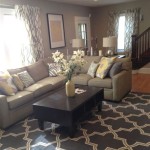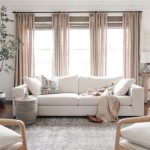Contemporary Living Room Color Schemes: A Comprehensive Guide
The contemporary living room serves as the heart of the modern home, a space for relaxation, entertainment, and social interaction. The selection of a suitable color scheme is paramount in establishing the desired atmosphere and aesthetic appeal. Contemporary design emphasizes clean lines, functionality, and a balance between comfort and sophistication. Therefore, contemporary color schemes often deviate from traditional palettes, embracing nuance, subtlety, and a strategic use of color to enhance the overall living experience.
This article aims to provide a comprehensive overview of contemporary living room color schemes, exploring various approaches, key considerations, and examples that will assist in creating a visually appealing and harmonious living space. Understanding the principles of color theory and how they apply to interior design is crucial for successful implementation. Factors such as natural light, room size, and personal preferences should also be taken into account when selecting a color scheme.
Understanding Contemporary Color Scheme Foundations
Contemporary design philosophy dictates a move away from overly ornate and cluttered spaces. This extends to color, where simplicity and intentionality reign supreme. Achieving a successful contemporary color scheme requires a solid understanding of foundational principles. These principles can be broadly categorized as neutrality, accent colors, and the interplay of textures.
Neutrality: Neutral colors form the backbone of most contemporary living room designs. Shades of gray, beige, white, and off-white provide a versatile canvas upon which to build a more complex color scheme. The selection of the specific neutral hue is crucial. Cool grays can create a sophisticated and minimalist ambiance, while warmer beiges offer a sense of comfort and approachability. White, especially in its various muted forms, promotes a feeling of spaciousness and airiness. The key is to choose a neutral that aligns with the desired overall mood and complements the existing architectural elements of the room.
Accent Colors: Accent colors introduce visual interest and personality to the neutral foundation. These colors are typically used sparingly, in elements such as throw pillows, artwork, rugs, or decorative accessories. The choice of accent colors is highly subjective and dependent on personal preferences, but certain trends and guidelines often apply in contemporary design. Popular accent colors include muted blues, greens, yellows, and earthy tones. The strategic placement of accent colors can draw the eye to specific focal points within the room and create a sense of balance.
Texture and Materiality: Texture plays a vital role in enriching contemporary color schemes. The interplay of different materials, such as wood, metal, glass, and fabric, can introduce subtle variations in color and enhance the overall sensory experience of the space. For example, a natural wood coffee table can add warmth and texture to a predominantly gray and white living room. Similarly, a plush velvet sofa can provide a luxurious contrast to a minimalist backdrop. The careful consideration of textures can prevent a neutral color scheme from feeling cold or sterile.
Exploring Different Contemporary Color Scheme Approaches
The application of color in a contemporary living room is not a one-size-fits-all solution. Several distinct approaches can be employed, each yielding a unique aesthetic outcome. Understanding these different approaches allows for a more informed decision-making process when selecting a color scheme.
Monochromatic Schemes: A monochromatic color scheme utilizes different shades and tints of a single color. This approach creates a sense of harmony and sophistication, and is particularly effective in smaller living rooms, as it can visually expand the space. For example, a living room might feature walls painted in a light gray, a sofa upholstered in a medium gray, and accessories in darker shades of gray. The key to a successful monochromatic scheme is to vary the textures and materials to prevent the space from feeling monotonous.
Analogous Schemes: An analogous color scheme incorporates colors that are adjacent to each other on the color wheel. This approach creates a sense of visual flow and harmony, and is often used to evoke a specific mood or feeling. For example, a living room might feature walls painted in a muted blue-green, a sofa upholstered in a teal fabric, and accessories in shades of green and blue. Analogous schemes tend to be calming and relaxing, making them well-suited for living rooms.
Complementary Schemes: A complementary color scheme utilizes colors that are opposite each other on the color wheel. This approach creates a sense of contrast and vibrancy, and can be used to add energy and excitement to a living room. For example, a living room might feature walls painted in a neutral beige, a sofa upholstered in a deep blue, and accessories in shades of orange and rust. Complementary schemes should be used with caution, as the high contrast can be overwhelming in large doses. It is generally recommended to use one color as the dominant hue and the other as an accent.
Triadic Schemes: A triadic color scheme employs three colors that are equally spaced on the color wheel. This approach creates a sense of balance and harmony, while still offering a degree of visual interest. For example, a living room might feature walls painted in a light gray, a sofa upholstered in a yellow fabric, and accessories in shades of blue and red. Triadic schemes can be challenging to execute successfully, as the colors need to be carefully balanced to avoid being overwhelming.
Practical Considerations for Color Scheme Selection
While aesthetic preferences play a significant role in color scheme selection, several practical considerations should also be taken into account. These considerations include the amount of natural light, the size of the room, and the existing architectural features.
Natural Light: Natural light has a profound impact on how colors appear in a living room. Rooms with ample natural light can handle darker and more saturated colors without feeling gloomy. Conversely, rooms with limited natural light benefit from lighter and brighter colors, which can help to maximize the feeling of spaciousness. It is essential to test paint colors in the actual living room under different lighting conditions before making a final decision.
Room Size: The size of the living room also influences the choice of color scheme. Smaller living rooms tend to benefit from lighter colors, which can visually expand the space. Darker colors can make a small room feel even smaller and more enclosed. Larger living rooms can handle a wider range of colors, but it is important to maintain a sense of balance and harmony. Consider using lighter colors on the walls and darker colors on the furniture to create a sense of grounding.
Architectural Features: The existing architectural features of the living room, such as fireplaces, windows, and moldings, should also be taken into account when selecting a color scheme. These features can serve as focal points and can be highlighted or minimized through the strategic use of color. For example, a prominent fireplace can be painted in a contrasting color to draw attention to it, while unattractive moldings can be painted in the same color as the walls to make them less noticeable.
Personal Preferences: Ultimately, the most important consideration when selecting a color scheme for a contemporary living room is personal preference. The living room should be a space that reflects the homeowner's individual style and personality. It is important to choose colors that evoke positive emotions and create a comfortable and inviting atmosphere. Don't be afraid to experiment with different color combinations and to incorporate personal touches into the design.
In conclusion, the selection of a contemporary living room color scheme involves a multifaceted approach that considers foundational principles, distinct approaches, and practical considerations. By understanding the nuances of color theory and applying them strategically, it is possible to create a living space that is both visually appealing and functionally harmonious. Balancing neutrality with carefully chosen accent colors, considering the interplay of textures, and taking into account factors like natural light and room size are all critical steps in achieving a successful outcome. The goal is to create a living room that reflects personal style while adhering to the principles of contemporary design.

17 Living Room Color Palettes Our Designers Love Havenly Interior Design Blog

17 Living Room Color Palettes Our Designers Love Havenly Interior Design Blog

30 Best Living Room Color Schemes Stag Manor

17 Living Room Color Palettes Our Designers Love Havenly Interior Design Blog
:strip_icc()/101912857-2add7c1aecd94670bb5e250ae7bf6138.jpg?strip=all)
How To Use Modern Colors For Sophisticated Calming Decor

30 Best Living Room Color Ideas Schemes Decoholic

Color Collections Hgtv Home By Sherwin Williams

74 Best Living Room Paint Color Ideas For 2025

17 Living Room Color Palettes Our Designers Love Havenly Interior Design Blog

27 Living Room Colour Ideas Best Schemes








